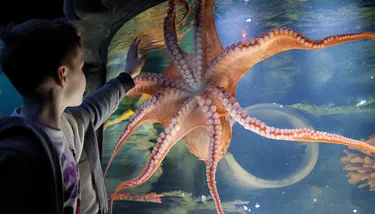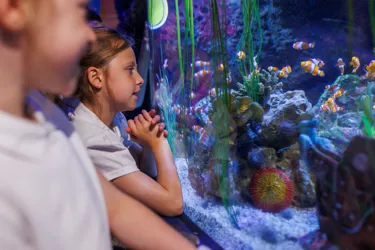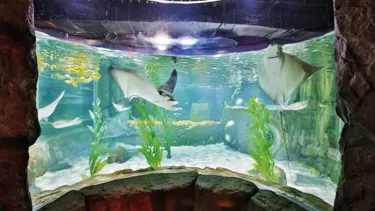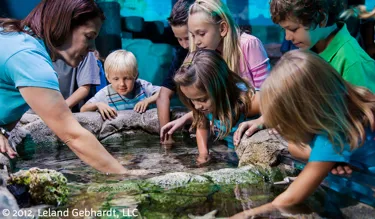How a School Aquarium Trip Can Help Students Feel Calm
- Tuesday 11th February 2025
- Laura Di Pasquale
- Student wellbeing, PSHE, learning outside the classroom

Imagine walking into the classroom on a Monday after a full moon and gale-force winds. You’ve managed to herd your pupils inside, but teaching feels impossible as chatter about Fortnite skins, football wins, and embarrassing tales from the weekend fills the air. Yet, amidst the chaos, you think of that PSHE lesson you’ve been saving. “What are we doing?” they ask. “Wellbeing!” Cue the groans, eye-rolls, and a loud, “This is gonna be boring!”
It’s no secret that the wellbeing of our children has taken a hit in recent years. From pandemic disruptions to the ever insisting presence of social media, young people face a barrage of pressures previous generations could never have imagined. However, what if there was a way to make learning about wellbeing fun, engaging, and memorable? Enter the humble aquarium trip!
Why Does Wellbeing Matter?
Before diving into the deep blue, let’s take the issue back up to the surface. Wellbeing is more than a PSHE buzzword. It’s about helping students to feel secure, valued, and resilient. Poor wellbeing can affect everything from academic performance to social relationships. Teachers are all too used to this; anxious hand-raisers, withdrawn daydreamers, and short-fused interrupters. While PSHE lessons address self-care and emotional health, students often tune out. Learning outside the classroom offers a fresh way to engage them.

The Magic of the Aquarium
Aquariums offer a unique blend of calm and curiosity, making them the perfect antidote to classroom stress. Imagine stepping into a tranquil space where jellyfish pulse like living lava lamps, sea turtles glide effortlessly, and the only sound is the soothing hum of water (not someone aimlessly tapping a pencil on the edge of their desks). It’s a sensory retreat no YouTube video can replicate.
School trips to aquariums aren’t just about marvelling at sharks, though their rows of teeth are fascinating. Did you know bull sharks can have fifty rows of teeth? Terrifying! These trips are about creating moments of wonder and connection. Studies have shown that interacting with nature - or even watching it through a glass tank - can lower stress and improve mood. For students grappling with big emotions, this can be transformative.
Linking it to the PSHE Curriculum
The best school trips are fun and purposeful. A trip to an aquarium ties in beautifully with the PSHE curriculum. Use it as a springboard to discuss topics like mindfulness (How does the rhythmic movement of fish make us feel?) or resilience (What can we learn from creatures that adapt to survive in harsh conditions?). Some ideas for teaching might include supporting students to write reflective journal entries about their favourite marine animal, having group discussions on protecting oceans, or even role-playing conservationists presenting solutions to environmental challenges. These activities go beyond ticking curriculum boxes - they make wellbeing relatable.

Benefits Beyond the Tanks
Let’s talk about the bigger picture. A school trip to an aquarium doesn’t just boost individual wellbeing; it can strengthen relationships across the board. Students bond over shared experiences, whilst teachers get the opportunity to interact with them outside the usual hectic classroom dynamics. Even the bus ride there, complete with the sick kids at the front and chatter about the special sugar-filled snacks they were given for the trip, becomes part of the magic of the experience. For kids who find it hard to make friends, this experience can be invaluable and provide an opportunity to connect with peers in a low-pressure setting. Quieter students will find the tranquil environment can be a safe space to express themselves. For everyone, it’s a reminder that learning can, and should, be an enjoyable adventure into the depths of the unknown.

Practical Tips for Teachers
Planning a school trip can feel daunting, especially when you’re juggling a million other responsibilities, including briefing the parent helpers on not taking pictures of the kids or leaving and taking their own child home if they get fed up. Here are some quick tips to make for a more seamless experience:
- Do your research: Many aquariums offer educational packages tailored to different age groups. These often include guided tours and hands-on activities which help to relieve the pressure of Googling facts as you traipse around with a group.
- Connect it to your curriculum: Use it to reinforce PSHE, science, or geography lessons and justify it to SLT with terms like “holistic experience” and “experiential learning.”
- Prepare students in advance: Discuss what they’ll see, set behaviour expectations, and assign mini-projects like finding the largest marine animal or identifying what puffins eat.
- Bring your sense of humour: Expect the unexpected - like a student who insists they’ve found the famous clownfish, only to discover it’s just a regular one named Paul.
A Ripple Effect
The impact of a trip to an aquarium doesn’t end when the coach pulls back into the school car park. The sense of wonder, calm, and connection lingers, creating a ripple effect on student wellbeing. You may even notice that students are more engaged and curious about marine life when they return to the classroom. The next time a student yells “wellbeing is boring”, skip the worksheets and take them on an adventure. Sometimes, the best teaching ideas start not with a textbook but with a tank full of fish. And who knows? Maybe you’ll even discover your own favourite sea creature. Mine’s a male seahorse - because they carry the babies! It’s a great reminder that nature doesn’t follow the rules we expect, and that’s what makes it so wonderful.
Here’s to teaching, exploring, and finally finding a school trip where everyone - yes, even you - has a whale of a time!
Related blogs

Ocean Conservation: Why Little Splashers Make Big Waves
Active citizenship might sound like something only MPs do, but for kids, it’s all about turning empathy into action. That’s where SEA LIFE’s Friends of the Sea initiative comes in. Think of it as a superhero training camp, minus the capes (although, who am I to stop you?)
Related blog posts
Dive into Learning: How Aquarium Trips Inspire Knowledge, Empathy, and Love for the Ocean
Planning a geography or science school trip can be a lot of work, but watching a child’s eyes light up when they enter an aquarium is a joy to behold. It’s a journey into the ocean’s mysteries, a chance to inspire empathy, and an opportunity to show students how interconnected our world truly is.
Related blog posts
Creative, captivating and colourful: Ocean-inspired learning for KS1&2
The world’s oceans are full of hidden depths when it comes to cross-curricular learning for KS1&2 teachers. Here are five ideas for ocean-themed projects – and how to integrate them into the classroom.
Related blog posts
Oceans at COP30 + engaging activities to dive into
For teachers, COP30 is a good way to connect global policy to the classroom, showing students that protecting the ocean isn’t just about wildlife, it’s about climate, people, and our shared future.
Related blog posts